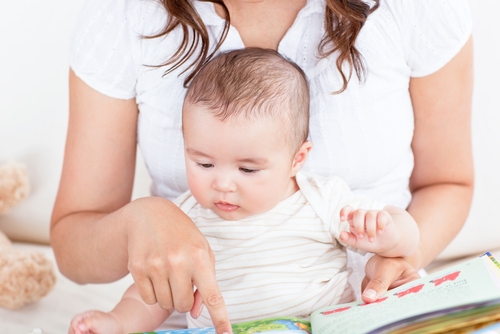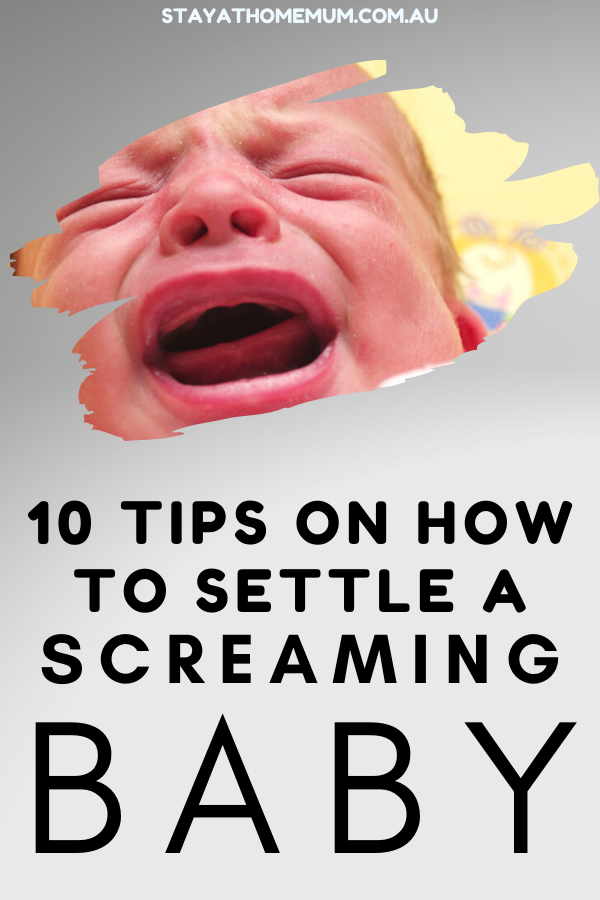
No mum ever wants to hear their baby cry lest scream their hearts out.
Crying is every baby’s way of communicating that something is bothering them. While it’s their way to tell us that they need something or something’s not right, we do our best to stop their crying. But sometimes, our best is not enough, or it’s just not what they want to keep them from crying even more.
So, we’ve put together some tips on how to settle a screaming baby. Whether you have a colicky baby or they just feel like crying or they’re really in pain, these tips can help you soothe and calm down your baby.
1. Make sure they aren’t in pain.
Sometimes, babies will scream because they are in a lot of pain, but they can’t tell you that. In a warm room, check over your baby’s body from head to foot. Check for any prickles, spikes or itchy marks. Check your baby’s feet to see if a thread might have wrapped itself around a toe (it happens a lot apparently!).
If your baby is pulling up their legs towards their chest, this action says that they have a pain in the belly. Belly pain is usually from gas or swallowing air when they feed.
2. Top up a feed with boob or bottle.
For breastfeeding mums, comfort nursing is one effective way to stop your bub from crying. Breastfed babies find solace in their mother’s breasts, skin, smell and the sound of her voice and heartbeat.
While for bottle-fed bubs, sucking their bottles or pacifiers provides them comfort and relaxes them. While you do this, keep your body close to them so they can feel your skin, breath, and hear your voice.
Nothing beats a mother’s care to soothe a crying baby.
3. Give baby a warm bath or shower with cuddles.
Most mums attest that giving babies a warm bath can ease their crying. Perhaps it’s the sound of running water and the warmth of the water on their skin. What you can do is get into the tub or shower with your little one, shower him/her with cuddles while in warm water and see the instant effect on your bub. The skin-to-skin contact also helps comfort your baby.

4. Lay baby over your arm and sway.
It’s one of the 5 S’s of soothing a baby: Swinging.
Putting him/her over your arm and sway either using fast, rhythmic movements like swinging, rocking, or jiggling will remind your bub of the days he/she was still inside you. See what type of swinging is best for him/her. Some babies calm down with more vigorous swaying, while others want soft and tender swinging.

5. Make sure baby’s environment is quiet and calming.
Creating an environment that’s free from noise and clutter can help keep your bub away from distractions, thus promoting sleeping.
You can also do another S in the 5 S’s of soothing a baby: Shushing.
Shushing to your little one comforts him/her as it sounds like the whooshing noise that was around him/her while he/she was in your womb, that is soothing for him/her. You can also use white noise that imitates the whooshing sound such as a radio tuned to static, apps such as White Noise or Ambiance 2.0 or any sound effect that could create white noise.

6. Read to baby softly.
A mother’s voice is the ultimate soothing relief for a crying baby. Apart from shushing, another way to let your bub hear your voice is by reading to them softly. Although they couldn’t yet understand a word you’re saying but it’s your voice that makes them feel comfortable and cosy. Your calm voice will then create a subdued mood that would indicate that it’s time for them to sleep.

7. Your baby might be over-tired.
It’s possible for babies too to be over-tired and exhausted from throughout the day’s exploring, running, playing, walking, or just about any activity they want to spend their day with. So when it’s time to sleep, sleeping sometimes becomes way over their heads.
To help your baby get more shut-eye, do bedtime habits that would calm them down. Pamela High, M.D., a colic expert at The Brown Center for the Study of Children at Risk, in Providence, Rhode Island in the US suggests giving bub a warm bath then playing a soothing music. It’s important for their room to be quiet and the lights, dimmed. “Babies don’t know the difference between day and night, so you have to teach them by behaving differently,” Dr. High says.

8. Go outside.
Sometimes, the atmosphere in your home, despite your effort to keep it quiet and calm as possible, is not enough to calm down your bub. So try to head outside and let him/her breathe in some fresh air, or just let him/her hear the whooshing sounds of the wind or the rustling of the leaves — all these would remind him/her of the sounds during the time she spent inside you.

9. Check for signs of colic or reflux.
If everything you did and said (and sang and danced) were to no avail, check for signs of colic or reflux. Studies show that around 26% or babies are colicky.
Colic happens around the baby’s 2nd week, peaks at 6 weeks, and is gone by the 16th week. It is defined as a baby’s crying for over three hours a day (sometimes on end), at least three days a week, although your bub can be considered colicky even if they did not meet these criteria.
Paediatrician Harvey Karp, MD, author of the book and DVD The Happiest Baby on the Block, explains that crying babies are actually just adjusting to the life outside of the womb, so some lights, colours, textures, and sounds upset them. Most often, it’s the hunger, gas or reflux that make them go wild.
What you can do to reduce gassiness in babies is doing some types of holding positions to help them relieve gassiness, such as the following:
- Football Hold
- Put your baby facedown along one forearm and support his/her neck by using the crook of your arm. Place your other arm between his/her legs to support his/her lower body.
- Over-the-shoulder Hold
- Hold your baby’s stomach against your shoulder and allow his/her head and neck to drape over it. Support his/her head with your other hand.
10. Ask for help.
A screaming baby and you, all alone, make you want to scream and cry yourself, right? When this happens, don’t hesitate to call someone — a friend, a family or anybody close to you, even a close neighbour to offer you help. Ask someone to watch over your baby for a while while you take your time out.
The more anxious you are, the more stressed out your baby will become (your bub knows and feels you), and these will not do anything good for you and your baby. Don’t feel bad and think you’re a bad mum. You’re not. You did everything you can, but it’s just not working on your bub. So don’t be too hard on yourself. Clear your mind and thoughts from any tension. This will help break the cycle and who knows, you might eventually come back to a more relaxed and calm baby (who more often grew tired of crying and has cried himself/herself to sleep).







 Top 14 Online Adult Shops in Australia
Top 14 Online Adult Shops in Australia  List of Environmentally Friendly Disposable Nappies (and...
List of Environmentally Friendly Disposable Nappies (and...  List of the Best Weight Loss Shake...
List of the Best Weight Loss Shake...  Where to Buy Wholesale Vibrators to Sell...
Where to Buy Wholesale Vibrators to Sell...  Our Honest Bed Threads Review 2021
Our Honest Bed Threads Review 2021 



